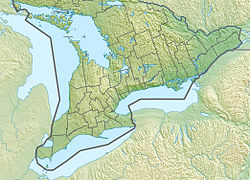Lake of Bays (Muskoka District)
| Lake of Bays | |
|---|---|

Pier at Dwight Beach
|
|
| Location | District Municipality of Muskoka, Ontario |
| Coordinates | 45°15′02″N 78°59′54″W / 45.25056°N 78.99833°WCoordinates: 45°15′02″N 78°59′54″W / 45.25056°N 78.99833°W |
| Primary inflows | Oxtongue River |
| Primary outflows | South Branch Muskoka River |
| Basin countries | Canada |
| Surface area | 70.53 km2 (27.23 sq mi) |
| Average depth | 22.25 m (73.0 ft) |
| Max. depth | 70.10 m (230.0 ft) |
| Water volume | 1,567,519,824 m3 (5.53564402×1010 cu ft) |
| Shore length1 | 170.59 km (106.00 mi) |
| Surface elevation | 315.47 meters (1,035.0 ft) |
| Islands | Bigwin Island, Fairview Island, Langmaids Island, Roothog Island, Crown Island, Millichamp Island, Mariebianca Island, Champion Island, Castle Island, Burnt Island, Shamrock Island, Ensko Island, Hanes Island, Zephyr Island, Pancake Island, Turner's Island, Haystack Island, Raynor Island, Reuben Island, Harper Island, Rock Island, Gardner Island, Vimy Ridge Island, Wee Island, Helen Island |
| Settlements | Baysville, Dorset, Dwight |
| 1 Shore length is not a well-defined measure. | |
Lake of Bays is a large lake in the District Municipality of Muskoka in Central Ontario, Canada. It is located in the Township of Lake of Bays, which is named after the lake. Ontario Highway 35 runs north and east of the lake.
Port Cunnington is a community established on a peninsula reaching out deep inside the lake. Other settlements on the lake shore include Dwight, South Portage, Baysville and Dorset.
The lake is fed by Oxtongue River, as well as other rivers and creeks flowing from the north-east (Boyne River and its tributary Sixteen Mile Creek, Ten Mile Creek, Hollow River, St. Mary Creek).
Bigwin Island is the largest island in the lake; other islands include Burnt Island, Fairview Island, Langmaids Island, Pancake Island, Raynor Island, Rock Island, Haystack Island, Millichamp Island, Reuben Island, Crown Island and Peanut Island. The irregular shape of the lake is defined by many bays such as Rabbit's Bay, Burnt Island Bay, Whitehouse Bay, Montgomery Bay, Portage Bay, Haystack Bay, Ten Mile Bay, Dwight Bay,Trading Bay and Murky Bay.
The First Nations apparently called the lake Num g e low e nee g go mark lak a hagan which means Lake of Forks. It was also known as Baptiste Lake, Forked Lake and Lake of Two Bays. In 1837, David Thompson traversed the lake and drew a map of the lake that refers to it as Forked Lake. On September 5, 1837, Thompson mentioned catching lake trout in the lake. Thomas Moffatt, an agent for the Hudson’s Bay Company (Moffatt reported an outpost on Bigwin Island) referred to it as Trading Lake. In 1853, a geological survey by Alexander Murray of the Geological Survey of Canada referred to the lake as Lake of Bays.
...
Wikipedia

